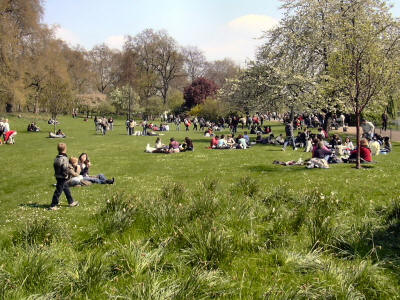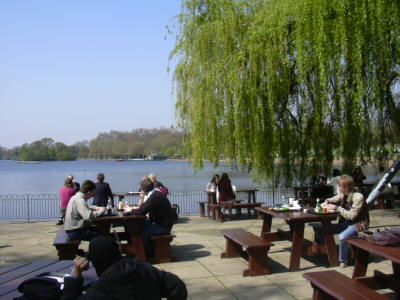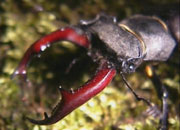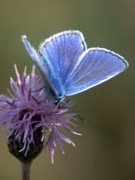

The London parks are very important for the English population because they can relax, meet their friends or family, play sport, discover nature and much more ...


Hyde Park is one of London's finest landscapes and covers
over 350 acres
.
Henry VIII acquired  mpletely. He had the Ring (north of the present Serpentine boathouses) created
and in 1637 opened the park to the general public.
mpletely. He had the Ring (north of the present Serpentine boathouses) created
and in 1637 opened the park to the general public.
In 1665, the year of the Great
Plague, many citizens of
Towards the end of the 17th century
William III moved his court to
Queen Caroline, wife of George II,
had extensive renovations carried out and in the 1730s had The Serpentine, a
lake of some
In 1866 Edmund Beales' Reform
League marched on
The
The Royal Parks offer a lots of opportunity for sports, whether serious and organised, or just for fun.
The Regent's Park is the largest open-air sports area in central London, with over 40 recently restored pitches for football, cricket, softball hockey and rugby; plus an athletics track; boules green, outdoor gym and tennis and netball .
Our other Parks also offer first class sporting facilities, from rugby to riding or softball to swimming - there's something for everyone in The Royal Parks!
Other
sports

Water
sports

During the summer season, you can hire boats and pedalos, have a swim,
or even go fishing in some parks.
Tennis

Football

Cycling

You can cycle on any road in the Royal Parks and on the specially
designated cycle routes.
Golf

The Regent's Park and Richmond Park are well known for their golf courses. Putting is available in Hyde and Greenwich Parks.
Cricket

Six new cricket squares will be available for the 2005 season in The Regent's Park -5 to club standard and 1 to county standard. Bushy Park has 5 cricket squares each with pavilion facilities.
Riding

As well as the routes available in Hyde Park, Bushy Park, and Richmond Park, the rugby field in Richmond Park serves for polo training and occasionally for matches by the Ham Polo Club.
flora and fauna

Biodiversity - or the richness and variety of living things - is a vital part of a healthy, sustainable environment.
Both Bushy and Richmond Parks have large areas of deer-grazed grassland with mature trees, woodlands, lakes and rivers. These habitats support an amazing array of wildlife, giving a sense of the wild and untamed in the middle of the urban landscape.
 Even in the more formal landscapes of the central Parks and Greenwich, wildlife areas
are maintained which are home to butterflies and moths, crickets,
grasshoppers and many other small creatures.
Even in the more formal landscapes of the central Parks and Greenwich, wildlife areas
are maintained which are home to butterflies and moths, crickets,
grasshoppers and many other small creatures.
The mixture of mature trees, shrubberies and grassland found in all the Parks provides shelter, nest-sites and foraging for birds such as green woodpeckers, stock doves, tawny owls, jays, tits, blackbirds, thrushes, robins and many more.
Grassland areas are important feeding grounds for birds such as pied wagtails, starlings and mistle thrushes. In the summer, the calls of house martins, swallows and swifts can be heard as they swoop and dive, catching insects on the wing. Many species of waterbird breed on the lakes and still more use the Parks as stop-overs during migration, or spend the whole winter with us.
 The formal gardens also play an important role for wildlife, especially
butterflies and bees that take nectar and pollen from the lush floral displays.
Cavities in mature trees provide nest sites for many birds and are also used by
roosting bats - all species of which are protected.
The formal gardens also play an important role for wildlife, especially
butterflies and bees that take nectar and pollen from the lush floral displays.
Cavities in mature trees provide nest sites for many birds and are also used by
roosting bats - all species of which are protected.
The Royal Parks are key players in the delivery of local and national biodiversity targets and active partners in both the London Biodiversity Partnership and the Biodiversity Action Plan. Theye play a strong role in the London Parks and Greenspaces Forum as well as other partnerships for the sustainable management of urban greenspace.
By Jonathan Flory and Francis Pechayre